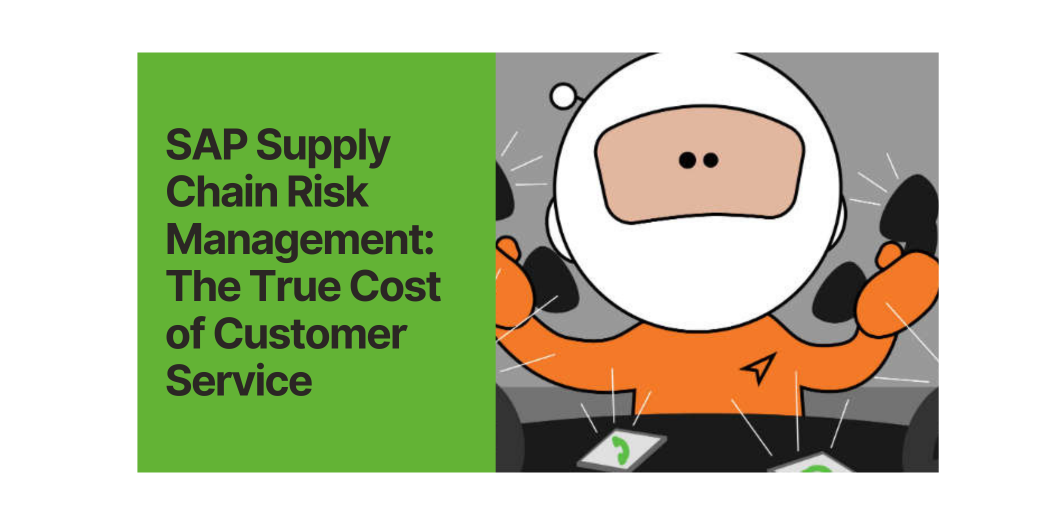SAP Supply Chain Risk Management: The True Cost of Customer Service
Lewis Marston
Sep 12, 2019 2:15:53 PM

Whether you're looking to optimise your business processes or streamline your operations, we have the expertise and experience to help you achieve project success.
Contact us today to discuss your needs further.
Learn how our SAP solution extensions can help your workforce reduce reliance on manual paper based activities and ensuring the ever changing needs of your supply chain operational workforce is supported.
Book a demo to learn more.
We work closely with our clients to understand their unique needs and challenges. Explore our SAP expertise services to learn more.

Personalisation of products, value-add customer service offerings and next day delivery are a few examples of strategies we see clients aiming to provide to achieve heightened customer retention and differentiation. Immediacy and seamless customer experiences like, for example, knowing to the minute when your delivery will arrive will continue to put pressure on supply chain operations and its a challenge that will not be going away in the near future. In order for personalisation and rapid order fulfilment to be successful supply chain leaders need to focus on creating not only responsive and flexible supply chains, but profitable ones too.
The challenge is that supporting the business in offering differing levels of customer service, for example personalised products or same day delivery, can place a huge burden on an organisation’s supply chain, profitability and potential to grow, with any value-add service requiring execution in a profitable way. This inevitably makes supply chain risk management more difficult.
Best-in-class organisations not only understand in real time the cost to serve for the expected service/product delivery, but also variations to this, such as dealing with requests for new value added services and changes to delivery and transportation requirements.
However, the challenge for many is having visibility of the true cost to service and impact (or potential impact) of these customer requested variations, with many organisations keen to say yes to the customer without calculating the impact to profitability.
So where does the responsibility lie? Traditionally, this level of visibility would not have reached the board. More space might’ve been made within a warehouse to service value-add, but with profit margins potentially being eroded by service differentiation, Supply Chain leaders can no longer avoid recognising the cost impact of these initiatives.
Many organisations are piling in a wide array of customer service, value-add options—for example, ‘can you add a bow’, ‘add the leaflet’ or ‘build personalised product configuration’—and it’s very easy for businesses to say yes without truly understanding the cost implications.
Without fully quantifying the cost of the service, each value-add service could diminish profitability, and there comes a point where you suddenly erode all of the margin from a customer.
What we recommend, and have seen many times when helping organisations through their journey of wholesaler/retailer/e-commerce models, is to gain insight into the actual profitability of servicing a customer. The cost of goods sold, warehousing costs and overall operational costs is usually clear, but the visibility into what bespoke services are creating additional costs from a specific customer may not be known. These costs are generally hidden well within the supply chain and accumulate by stealth.
Being able to see the true cost-to-service at a customer level is the optimum outcome from a digital supply chain, while it is also necessary to understand the potential further impact on profitability.
Within one warehouse you may have a customer who has no value added service and another being serviced with numerous additional services.
The first thing to do is gain visibility of the true cost to service each customer.
The second element is helping the board and finance stakeholders flip this scenario around. When a customer says “Can you do ‘x’ for me?”, an informed investment decision needs to be made. Through simulation you will be able to see whether or not you can absorb it into your price-to-sell or that you should be classing this is a chargeable service to the customer.
Historically, these decisions are relayed to customer services to make the decision if the additional value-add service is possible. They may say yes or move the query onto manufacturing, and so on up the supply chain. Before you know it, you have a compounding effect of incremental cost through diversification of previously uniform processes all having a detrimental effect on efficiency.
We have seen this with many of our customers across retail, manufacturers and distributors, and consumer products wholesalers. With a common theme that teams involved in managing and designing customer-specific activities don’t have the necessary detailed information to properly understand the cost impacts of these.
Looking across your whole supply chain, you need the tools to decide if you can offer this service to the customer and where best to fulfil this service request in the supply chain;for example it may be including the personalisation service within manufacturing process is most efficient and can meet the lead time or it may be better within the warehouse as late as possible in the customer fulfilment process as would be seen with a classic postponement strategy. Deciding can only be done when you have the supporting supply chain cost based planning and execution information
In today’s highly competitive market, it can be tempting for organisations to over accommodate customer requests, regardless of their complexity or cost, just to secure market share. However, when it is poorly planned and decisions are taken and pricing is set without clear visibility of additional costs involved, this strategy for attracting/retaining and serving customers can be a false economy, and quickly erode an otherwise profitable revenue stream.
Want to find out more about uncovering hidden costs within the supply chain? Click below to take a look at our free resource, the CFO Performance Enabler.